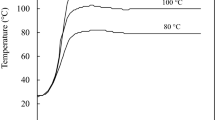Summary
Analyses and comparisons of a number of representative samples have shown that acidulated coconut oil soapstock may have an iodine value as much as 100% greater than that of the corresponding refined oil without any contamination being involved. Exactly what the spread between any given soapstock and oil will be apparently depends on the free fatty acid content of the original crude oil and the relative efficiency of the refining process. It was found that, for coconut soapstocks produced by standard laboratory refining tests, the relation between free fatty acid content and iodine value spread can be represented by the formula I.V. Spread=9.5–759 FFA. The efficiency of the refining process affects results insofar as it reduces the entrainment of neutral oil. Removing all of the neutral oil from four laboratory-produced soapstocks prior to acidulation raised the iodine value approximately two units in all cases.
The practical significance of these results is obvious. A refiner processing high grade crude coconut oil of 9.5, iodine value by a highly efficient refining procedure cannot be expected to produce an acidulated soapstock of less than about 18.0 in iodine value. With higher free fatty acid crude oil and less efficient refining procedures lower iodine values are possible, but since soapstock is of minor economic value compared to refined oil, the trend will always be toward better grade crude oils and more efficient refining processes.
Similar content being viewed by others
References
Peterson, W. A., “Proceedings of a Six-Day Short Course in Vegetable Oils”, A.O.C.S. Univ. of Ill., August, 1948.
Wurster, O. H., Govan W. J. Jr., and Stockmann, G. J., “Cottonseed and Cottonseed Broducts”, A. E. Bailey, editor, Interscience, New York, 1948, p. 812.
Jamieson, G. S., “Vegetable Fats and Oils”, Reinhold, New York, 2nd ed., 1943, p. 155, and p. 206.
Bailey, A. E., “Industrial Oil and Fat Products” Interscience, New York, 2nd ed., 1951, pp. 646–649.
U. S. Patent 2,319,929.
Tomssen, E. G., and McCutcheon, J. W., “Soaps and Detergents”, Macnair-Dorland, New York, 1949, p. 497.
Bailey, A. E., “Industrial Oil and Fat Products”, Interscience New York, 2nd, ed., 1951, p. 136.
Same as 7, p. 40.
Gulino, E. A., and Newby W., J. Am. Oil Chem. Soc.26, 418 (1949).
Arenson, S. W., and Heyl, E. G., J. Am. Oil Chem. Soc.,20, 150 (1943).
Nicholsen, R., and Formo, M. W., J. Am. Oil Chem. Soc.,26, 329 (1949).
Shuraev, G. I., and Vasil'eau, V., Chem. Abs.35, 6471.
Author information
Authors and Affiliations
About this article
Cite this article
Kuber, S.R., Newby, W.H. Iodine values of acidulated coconut oil soapstock. J Am Oil Chem Soc 30, 246–249 (1953). https://doi.org/10.1007/BF02638324
Received:
Issue Date:
DOI: https://doi.org/10.1007/BF02638324




